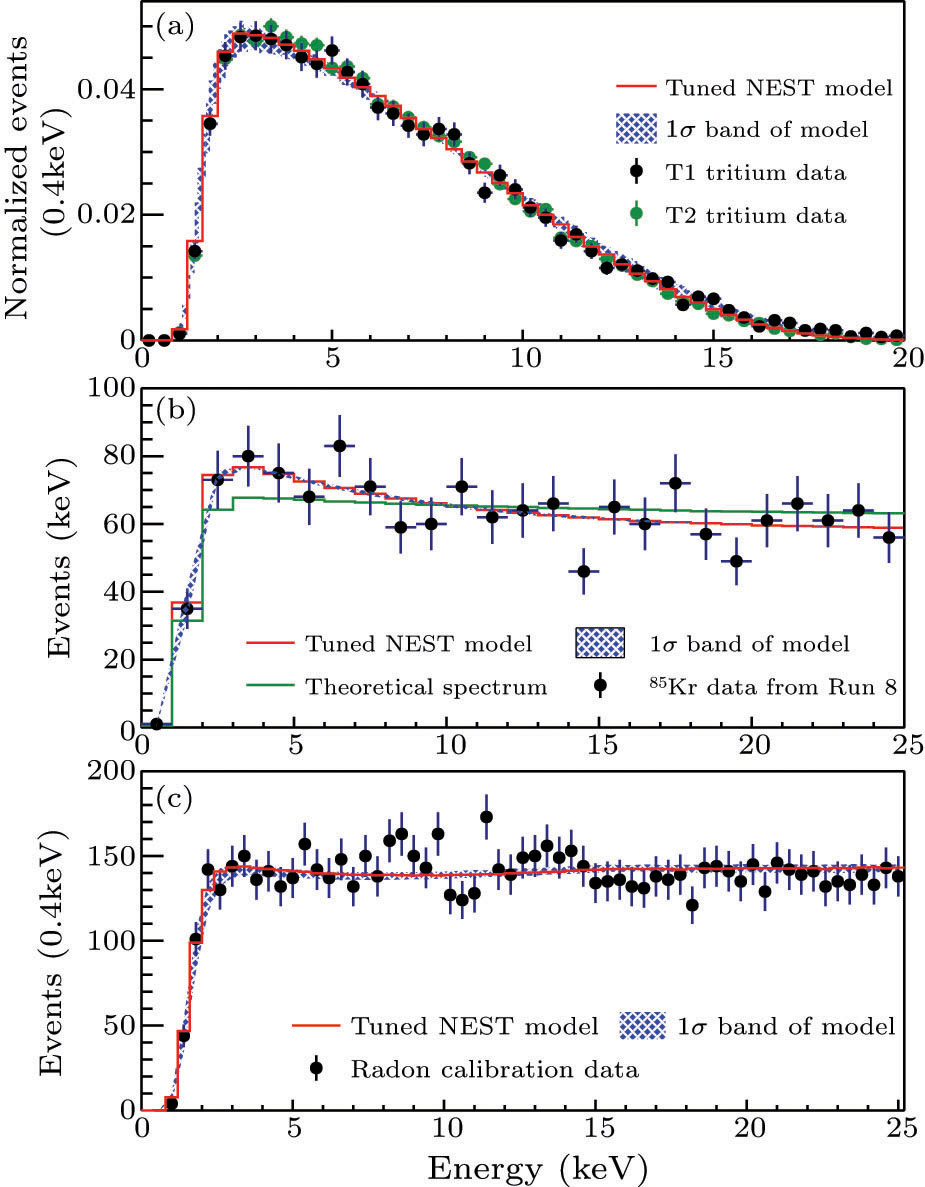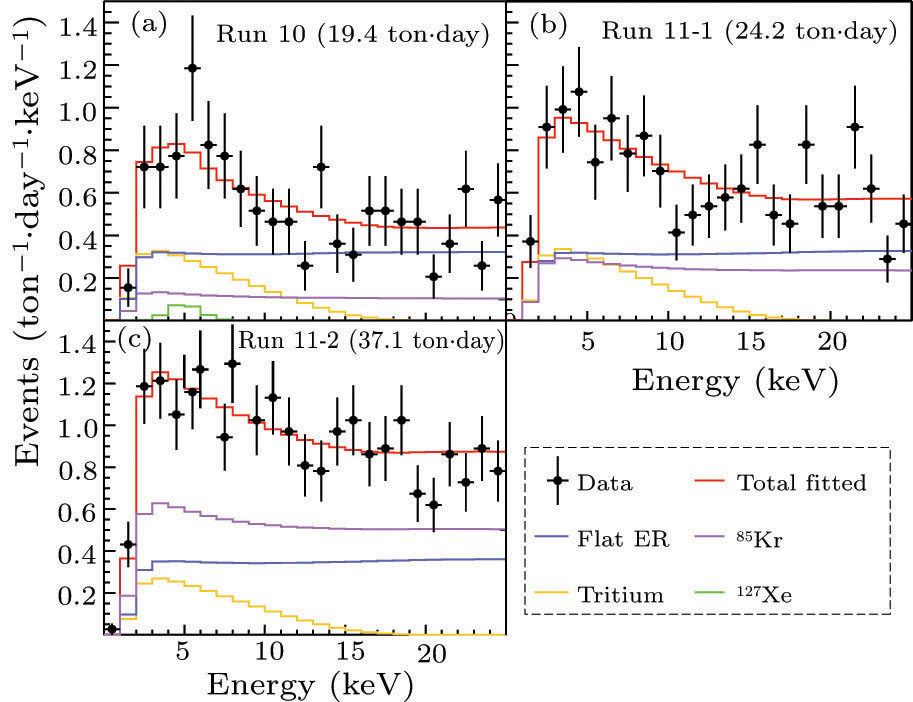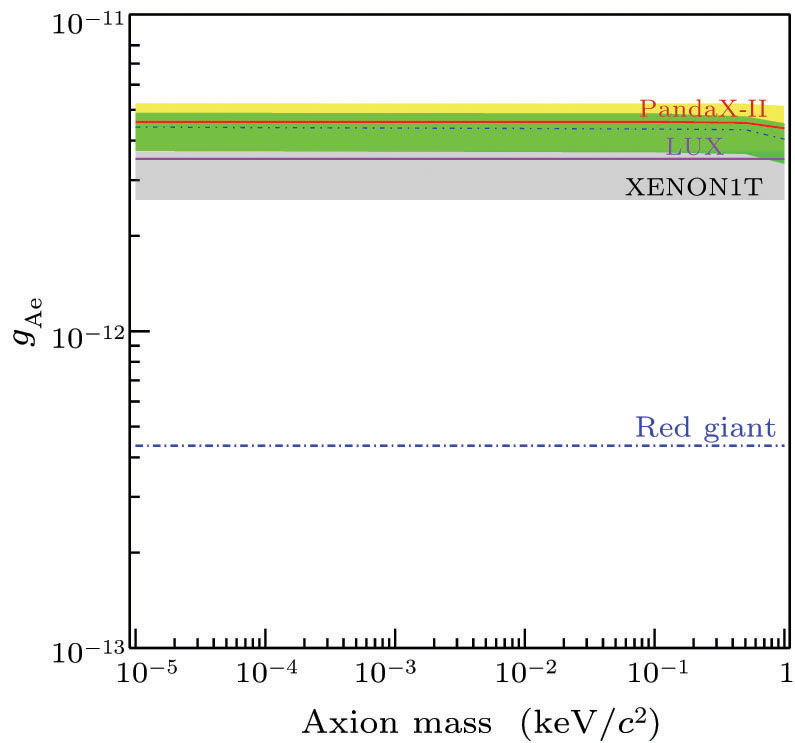Abstract
We report a search for new physics signals using the low energy electron recoil events in the complete data set from PandaX-II, in light of the recent event excess reported by XENON1T. The data correspond to a total exposure of 100.7 ton⋅day with liquid xenon. With robust estimates of the dominant background spectra, we perform sensitive searches on solar axions and neutrinos with enhanced magnetic moment. It is found that the axion-electron coupling gAe < 4.6 × 10–12 for an axion mass less than 0.1 keV/c2 and the neutrino magnetic moment μν < 4.9 × 10–11 μB at 90 % confidence level. The observed excess from XENON1T is within our experimental constraints.
Export citation and abstract BibTeX RIS
Dark matter particles have been searched extensively in underground low background experiments in the past few decades.[1–3] Nuclear recoil (NR) signals from dark matter-nucleus collisions, with a typical energy scale of 10 keV, are mixed primarily with electron recoil (ER) background due to gamma or beta radioactivity. Many experimental techniques have been developed to suppress the ER background, and to enhance the capability to identify NR signals. At the same time, utilizing the ER events to search for new physics signals such as dark matter-electron scattering,[4–10] axion-electron interactions,[11–15] and neutrino-electron scattering via neutrino magnetic moment[16–19] also becomes increasingly appealing.
Recently, XENON1T released the energy spectrum of ER events in their dark matter search data.[20] With an exposure of 0.65 ton⋅year with liquid xenon target, an excess of about 53 ± 15 events is identified between 1 to 7 keV above expected background. They report that such an excess is consistent with a non-zero solar axion-electron coupling constant gAe at 3.5σ, or solar neutrino-electron scattering with anomalously large magnetic moment at 3.2σ. However, the excess could also be explained by a trace amount of unexpected tritium in the detector.[21,22] In this Letter, we report an independent investigation of the low energy ER data from the full exposure of PandaX-II, where the spectra of dominant background components are well controlled by direct measurement or calibration.
PandaX-II is a 580-kg dual-phase liquid xenon experiment,[23] operating in the China Jinping Underground Laboratory.[24] The setup of the experiment has been reported before,[23,25,26] so only essential information relevant to this analysis is provided here. The PandaX-II target is a cylindrical-shaped time projection chamber. Liquid xenon is continuously purified through two circulation loops with a total mass flow rate of about 560 kg/day through hot getters.[27] The photons from the prompt scintillation (S1) and delayed electroluminescence photons from ionized electrons (S2) are detected by a top and bottom array of 3-inch photomultiplier tubes (PMTs). Single-scatter events are selected with a requirement of one S1 and one S2 signal based on which the three-dimensional position of the interaction can be reconstructed. The energy of the event is reconstructed by a linear combination of S1 and S2 as, Erec = 13.7 eV (S1/PDE + S2/EEE/SEG), in which the PDE, EEE, and SEG refer to the average photon detection efficiency, electron extraction efficiency, and single electron gain, respectively, and can be calibrated using full absorption ER peaks.
The complete data sets, including Run 9, Run 10, and Run 11, are used.[28] In between Run 9 and Run 10 in summer 2016, an ER calibration campaign was carried out with tritiated methane injection (named T1), with a peak tritium rate of 1 Bq, corresponding to a 2.1×10–19 mol/mol of tritium concentration in the target. After the calibration, attempts were made to remove the methane through the hot getter, an effective approach demonstrated by the LUX collaboration.[29] However, after the initial decrease, the tritium rate plateaued in the detector to about 1 mBq. In order to reduce this background, xenon from the detector was recuperated and distilled in spring 2017, during which the detector was completely warmed up and flushed with warm xenon through the hot getters. Run 10 was resumed after the distillation campaign, and a significant decrease of tritium level was observed.[26] Afterwards, an extended data taking (Run 11) was carried out, but divided into two spans (11–1 and 11–2) due to an unexpected air leakage in between leading to different background levels.[28] Instead of tritium, we injected short-lived 220Rn into the detector for ER calibration. After Run 11, another tritium calibration was performed (T2). The two tritium injections, separated by three years, allow us to make an accurate measurement of their spectra, which eliminate potential systematic uncertainty in spectral modeling in this analysis.
The low-level analysis in this work follows the same procedure as that in Ref. [26]. The data quality cuts (determined blindly) in the main dark matter analysis are adopted, although the range of energy is widened (see later). Detector parameters PDE, EEE, and SEG are taken from Ref. [28]., which are consistent among the three data sets within 10% (fractional).
To select the final set of ER events, the radius cut is modified from r2 < 720 cm2 in the dark matter search[28] to 550 cm2 to suppress the so-called surface background to less than one event. The corresponding fiducial mass is 251 kg. Also different from the main dark matter analysis, the energy region is extended to 25 keV so as to have better control of the shape of the beta-emitting background in the detector. Within this range, the tritium, 85Kr, material radioactivity and 222Rn are the four major background components. The expected energy spectra from the material, 222Rn, and solar neutrinos are mostly flat below 25 keV. For simplicity and to avoid degeneracy in the spectral fit, they are combined into a single component, named the "flat ER" background in short. The residual background including 136Xe, accidental coincidence of isolated S1 s and S2 s, and neutron events are all taken from the dark matter analysis but with updated fiducial volume cut. Contributions of 39Ar and 37Ar are estimated to be negligible in these data sets.
The critical ingredient of this analysis is to have a robust estimate of the background spectra. At low energy, a subtle instrumental non-linearity arises from the baseline suppression (BLS) threshold which introduces channel-wise signal inefficiency, particularly for PMTs operated under low gains. As a result, both S1 and S2 are subject to suppression factors,[28] leading to a nonlinear compression of the spectrum and apparent excess of events towards the low end. A special calibration was carried out to measure the two suppression factors directly at different PMT gain settings,[28] so the BLS effects can be properly corrected for the entire data set. This is particularly important in our understanding of the tritium spectrum, as its shape could be distorted more acutely. The validity of the BLS correction is demonstrated in Fig. 1(a), where a comparison is made on tritium energy spectra in T1 and T2, corrected for their corresponding BLS effects. The two spectra agree with each other with χ2/NDF = 69.4/50. The measured spectra are also in good agreement with the tuned NEST2.0 model,[30] with parameters identical to those used in the dark matter analysis.[28]
Fig. 1. (a) BLS-corrected tritium energy spectra from T1 and T2, and the NEST model; (b) measured spectrum of 85Kr, our best fit, and a recent theoretical evaluation; (c) measured 220Rn calibration data in comparison with the NEST model. The shaded area represents systematic uncertainty in spectrum shape due to PDE (4.9% rel. uncert.), EEE×SEG(4.8% rel. uncert.), and the BLS corrections.
Download figure:
Standard imageThe spectrum of 85Kr background is measured directly using our commissioning data sets (Run 8), where a high 85Kr concentration is identified and contributes to more than 98% of the low energy ER events.[25] The shape of 85Kr is extracted by fitting the data with an exponential function, as shown in Fig. 1(b). A recent theoretical calculation[31] is compared with the data, where a sizable difference is observed, indicating potential systematics from both ends. In this analysis, the difference is conservatively taken as the shape uncertainty of 85Kr.
The shape of the flat ER background is studied with the 220Rn injection data.[32] For comparison, using the ER model in Ref. [28]. with a flat input energy spectrum, the resulting Erec is in good agreement with the data (χ2/NDF = 48.7/63), as shown in Fig. 1(c). Theoretical shape uncertainties of the flat ER components including 214Pb[20,31] are taken into account, which are of up to a few percent level, and have less than 1% impact on the final spectrum fit.
Totally 2121 events survive after all cuts, with 646, 249, 387, and 839 events in Run 9 (20.0 ton⋅day), Run 10 (19.4 ton⋅day), Run 11–1 (24.2 ton⋅day), and Run 11–2 (37.1 ton⋅day). With tightened fiducial volume cut, we omit the position dependence in this analysis and generate background and signal probability density functions in two-dimensional space of S1 and S2.
An unbinned likelihood fit is performed to test the background and signal hypotheses, where the construction of likelihood function is identical to that in Ref. [26]. In Runs 10 and 11, to estimate the tritium contribution, a background-only pre-fit is performed independently for each run (span). The fit results are shown in Fig. 2. The resulting tritium rates are 0.041 ± 0.013, 0.043 ± 0.014, and 0.035 ± 0.019 μBq/kg for Runs 10, 11–1, and 11–2, consistent with a constant tritium decay rate where the statistical uncertainty is dominant. Another fit is performed with a common tritium normalization in the runs. The best fit tritium rate is 0.040 ± 0.010 (stat. + sys.) μBq/kg, translating into a concentration of (4.9 ± 1.2) × 10–24 mol/mol in xenon. Similar fitting test is performed with Run 9 data, and the result is consistent with the tritium-free scenario as expected. Therefore, in the signal hypothesis test discussed below, tritium background is not considered in Run 9 and the overall tritium normalization in Runs 10 and 11 is floating in the fit.
Fig. 2. Electron recoil energy distributions for Runs 10, 11–1, and 11–2 with background-only pre-fits. Likelihood fits are performed in two-dimensional space. The background due to 136Xe, neutron, and accidentals is not drawn in the figure.
Download figure:
Standard imageTable 1 summarizes the background composition from the background-only fit. The summed energy spectrum from all runs is shown in Fig. 3, with best-fit background contributions superposed. The data are consistent within 1σ fluctuation of the background-only hypothesis.
Fig. 3. Low energy spectrum of electron recoil events for the total 100.7 ton⋅day data. Simultaneous best-fit background contributions are overlaid, where tritium background rate is treated as the same in Runs 10 and 11. The expected axion signal with XENON1T best-fit signal strength is shown by the dashed grey line.
Download figure:
Standard imageTable 1. Summary of the best fit background values and data from the background-only likelihood fit.
| Events | Run 9 | Run 10 | Run 11–1 | Run 11–2 |
|---|---|---|---|---|
| 127Xe | 77.3 | 3.5 | 0.0 | 0.0 |
| Tritium | 0.0 | 49.6 | 60.1 | 92.2 |
| 85Kr | 418.2 | 51.1 | 146.0 | 479.7 |
| Flat ER | 143.6 | 145.8 | 176.1 | 270.1 |
| Accidental | 1.5 | 0.8 | 0.8 | 1.2 |
| Neutron | 0.6 | 0.4 | 0.5 | 0.8 |
| 136Xe | 2.3 | 2.2 | 2.7 | 4.1 |
| Total | 648.1±35.3 | 251.2±22.1 | 386.1±32.5 | 848.1±52.7 |
| Data | 646 | 249 | 387 | 839 |
Based on the above, we perform tests on the axion and neutrino magnetic momentum hypotheses with our data. For the axion hypothesis, we consider the Atomic recombination and de-excitation, Bremsstrahlung and Compton (ABC) solar axion model.[11] The best fit axion signal yields 15.8 events with statistical-plus-systematic uncertainty band [0,84.8]. Assuming XENON1T best fit signal strength[28] (gAe = 3.15 × 10–12 for axion mass smaller than 0.1 keV/c2), the expected number of signals would be 20.4 events in PandaX-II. Therefore, our data is compatible with XENON1T excess within 1σ in number of events, but is also consistent with background fluctuations.
To set the exclusion limit, we use the so-called CLs+b method[33] based on profile likelihood ratio[34] to make differential comparison of our data with background-only and background-plus-signal hypotheses. The best fit to our data is compared to fits to pseudo-data sets produced at individual signal strength, including statistical fluctuations and spectral shape uncertainties discussed earlier. Constraints on the coupling constant gAe at 90% confidence level (C.L.) are shown in Fig. 4. For the axion mass smaller than 0.1 keV/c2, the upper limit on gAe is at 4.6 × 10–12, corresponding to 90.9 signal events. The neutrino magnetic moment hypothesis is tested in the same way, which yields an upper limit of μν at 4.9 × 10–11 μB, corresponding to 191.6 signal events, as shown in Fig. 5. They represent one of the tightest experimental constraints on the solar axion-electron coupling and neutrino magnetic moment.
Fig. 4. The upper limits on the solar axion coupling constant gAe (90% C.L.), overlaid with that from LUX.[35] The best fit region (90% C.L.) from XENON1T[20] for gAγ < 10–10 GeV–1 is shown as a shaded grey region. The green and yellow bands represent the ±1σ and 2σ sensitivity bands and the dashed line represents the median sensitivity. The upper bounds from red-giant branch observation are also included.[36]
Download figure:
Standard imageFig. 5. The upper limits on the neutrino magnetic moment (90% C.L.) is shown in red. The allowed range from XENON1T[20] is marked in green and constraints from other observations[37–40] are shown in black.
Download figure:
Standard imageIn summary, we have performed an analysis using the low energy ER data from the full data set of PandaX-II with the total exposure of 100.7 ton⋅day. Tritium was introduced into PandaX-II during a calibration campaign in 2016 and after the end of physics data taking. The residual of tritium in the physics data is fitted to be 0.040±0.010 μBq/kg, with its shape tightly constrained by calibration. The spectra of 85Kr and 220Rn are also extracted from the data directly. With these data-driven background spectra, a search for the solar axion and neutrino magnetic moment signals is carried out. The expected excess assuming the best fit signal strength from XENON1T is compatible with our data within uncertainties, but our data are also consistent with background-only hypothesis. Upper limits at 90% C.L. on the solar axion and neutrino magnetic moment hypotheses are reported, with gAe < 4.6 × 10–12 and μν < 4.9 × 10–11 μB. The next generation of the PandaX liquid xenon experiment, PandaX-4T and its successor,[41,42] is expected to lower the electron recoil background rate and increase the fiducial volume. Together with the upcoming XENONnT[43] and LZ,[44] a more definitive answer to the XENON1T excess can be expected in the near future.
We thank the CJPL administration and the Yalong River Hydropower Development Company Ltd. for indispensable logistical support and other help. We also thank Dr. Amir Khan for careful checking of the draft.
Footnotes
- *
Supported in part by the National Key R&D Program of China (Grant No. 2016YFA0400301), the National Natural Science Foundation of China (Grant Nos. 11525522, 11775141, and 11755001), the Double First Class Plan of the Shanghai Jiao Tong University, the China Postdoctoral Science Foundation (Grant No. 2018M640036), the Office of Science and Technology, Shanghai Municipal Government (Grant Nos. 11DZ2260700, 16DZ2260200, and 18JC1410200), and the Key Laboratory for Particle Physics, Astrophysics and Cosmology, Ministry of Education, for important support. We also thank the sponsorship from the Chinese Academy of Sciences Center for Excellence in Particle Physics (CCEPP), the Hongwen Foundation in Hong Kong, and the Tencent Foundation in China.




